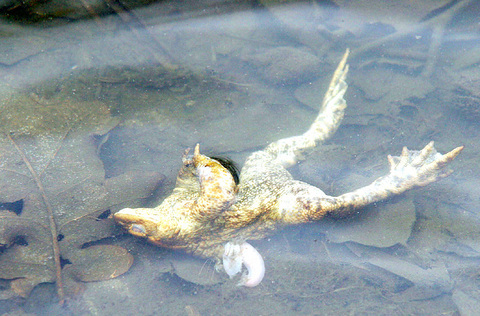In the spring of 2005, a bizarre and unsettling phenomenon baffled scientists and locals in Hamburg, Germany: frogs and toads in the Altona district were mysteriously exploding. These amphibians, observed with inflated bodies before bursting, left behind an eerie scene of devastation in their wake. Witnesses described hundreds of amphibians perishing in this gruesome manner, sparking curiosity and concern worldwide. Scientists and ecologists scrambled to uncover the cause, leading to a fascinating journey into the complex interactions between species and environmental stressors. This case remains a vivid example of how intricate and fragile ecosystems can be.

The Mysterious Phenomenon
The phenomenon of exploding frogs and toads began abruptly, catching the attention of researchers and conservationists. Observers noted that affected amphibians would swell dramatically before rupturing, projecting internal organs and fluids up to a meter away. The mortality rate was staggering, with reports estimating over 1,000 toads affected within a short span. This situation puzzled scientists, as no toxins or infections were immediately identified as the cause. Speculation ranged from chemical pollutants to a strange behavioral anomaly triggered by stress or environmental changes.
Investigating Possible Causes
Initial investigations ruled out common causes like bacterial or viral infections. Researchers turned their attention to potential environmental factors, including water pollution and habitat disruption. Hamburg’s Altona district, where the incident occurred, is home to urban ponds often affected by runoff and contaminants. However, water samples failed to reveal significant anomalies that could directly explain the amphibians’ condition. The focus then shifted to predatory interactions as a potential explanation for this unusual event.
The Role of Crows in the Mystery
Scientists eventually discovered that local crows were a key factor in the bizarre explosions. The birds, known for their intelligence and opportunistic feeding habits, targeted the amphibians’ livers—a nutrient-rich organ. To access the liver, crows would peck through the amphibians’ skin, leaving them vulnerable and triggering a defensive reaction. This process caused the toads to inflate their bodies—a natural defense mechanism that went horribly wrong without the liver intact. The rupturing occurred when the inflation exceeded the toads’ physical capacity, solving the mystery of their sudden demise.
Environmental Stressors and Amphibian Vulnerability
This incident highlights the delicate balance of ecosystems and the impact of external pressures on wildlife. Urbanization and habitat encroachment often force species into unnatural interactions, increasing stress and vulnerability. In Hamburg, limited food sources and shrinking habitats likely pushed crows to adapt their feeding strategies. Amphibians, already sensitive to environmental changes, became unintended victims of this adaptation. This case serves as a reminder of the unintended consequences of human activity on wildlife populations.
The Global Amphibian Decline
The exploding toads of Hamburg are part of a broader issue: the alarming decline of amphibian populations worldwide. Over 40% of amphibian species are currently at risk of extinction due to factors like habitat destruction, climate change, and pollution. Amphibians play a crucial role in ecosystems, acting as both predators and prey, and their decline can have cascading effects. The Hamburg incident underscores the vulnerability of these species and the urgent need for conservation efforts. Addressing these challenges requires a multifaceted approach involving habitat restoration and stricter environmental protections.
Key Factors Behind Amphibian Decline
- Habitat destruction due to urbanization.
- Pollution from agricultural and industrial activities.
- Climate change affecting breeding cycles.
- Introduction of invasive species disrupting ecosystems.
- Spread of diseases like chytridiomycosis.
- Pesticide use impacting food sources.
- Overharvesting for the pet trade or consumption.
Watch Live Sports Now!
Dont miss a single moment of your favorite sports. Tune in to live matches, exclusive coverage, and expert analysis.
Start watching top-tier sports action now!
Watch NowVote
Who is your all-time favorite president?
Lessons Learned from Hamburg
The exploding toads case offers valuable insights into how species interact and adapt to environmental pressures. It emphasizes the importance of monitoring ecosystems to detect early signs of imbalance. Proactive conservation measures could prevent similar occurrences, protecting both wildlife and biodiversity. Hamburg’s urban ponds are now monitored more closely, serving as a model for managing human-wildlife interactions in urban settings. This incident also highlights the need for community engagement in environmental stewardship.
The Importance of Biodiversity Conservation
Biodiversity is essential for maintaining ecological stability and supporting human well-being. Amphibians, often overlooked, are critical indicators of environmental health due to their sensitivity to changes in water and soil quality. Protecting amphibians benefits the entire ecosystem, ensuring clean water sources and balanced food webs. In urban areas, creating green spaces and preserving wetlands can mitigate the impacts of habitat loss. Collective action is key to addressing the global biodiversity crisis.
Simple Actions to Support Amphibian Conservation
- Reduce pesticide and chemical use in gardens.
- Preserve natural wetlands and ponds.
- Support organizations focused on amphibian conservation.
- Participate in citizen science projects.
- Advocate for stricter environmental policies.
- Create amphibian-friendly habitats in your yard.
- Educate others about the importance of amphibians.
| Location | Species Affected | Main Cause |
|---|---|---|
| Hamburg, Germany | Common Toad | Crow predation |
| Central America | Golden Frog | Chytrid fungus |
| Australia | Tree Frogs | Habitat loss |
A study by the International Union for Conservation of Nature (IUCN) found that amphibians are among the most threatened groups of animals, with over 500 species already extinct. This highlights the critical need for global conservation efforts.
The exploding toads in Hamburg remind us of the complex and interconnected nature of life on Earth. As we strive to coexist with nature, understanding and addressing the challenges faced by vulnerable species is paramount. Reflect on how your actions impact the environment, and consider how you can contribute to conservation efforts. Share this story to spark awareness and inspire others to protect our planet’s biodiversity. Together, we can create a sustainable future for all living creatures.